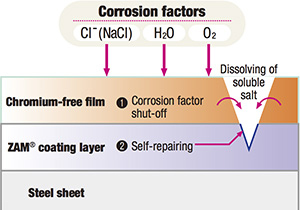Electrical conductivity
equivalent to that for
chromate treatment
+ Weldability
A list of chromium-free treatments for ZAM™
Anticorrosion mechanism of films
Mechanism of corrosion control by chromium-free film
(1)Corrosion control with environmental deprivation
The chromium-free film covers the coating layer uniformly
to prevent direct contact with corrosion factors.
to prevent direct contact with corrosion factors.
(2)Corrosion control by self-repairing function
If the chromium-free film is damaged due to processing
for instance, soluble salt dissolves under a moist environment to
form insoluble salt at the damaged are for self-repairing.
for instance, soluble salt dissolves under a moist environment to
form insoluble salt at the damaged are for self-repairing.


















